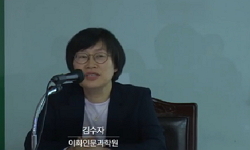This paper is designed to reconsider the status and one’s awareness of popular Japanese cultural contents in Korea in the state of recent deteriorating Korea-Japan relationship. Especially, it has examined factors of popularity and various implicati...
http://chineseinput.net/에서 pinyin(병음)방식으로 중국어를 변환할 수 있습니다.
변환된 중국어를 복사하여 사용하시면 됩니다.
- 中文 을 입력하시려면 zhongwen을 입력하시고 space를누르시면됩니다.
- 北京 을 입력하시려면 beijing을 입력하시고 space를 누르시면 됩니다.

애니메이션 <진격의 거인>의 인기 요인과 일본문화콘텐츠로서의 함의 연구 = A Study on the Factors of Popularity of “Attack on Titan”, an Animated Film, and the Implication as a Japanese Cultural Content
한글로보기부가정보
다국어 초록 (Multilingual Abstract)
To sum up, this paper shows that what kind of strengths of Japanese cultural contents are making the controversial work continue to be popular. Also, it proves that the film has various implications with interesting and exciting symbols like giants, cannibalism, and fear etc. Furthermore, it confirms that the potential of Japanese cultural contents in the active use of traditional Japanese cultural archetype. Finally, through these kinds of implementation method, it can offer one of the opportunities to redefine the current position of Japanese cultural contents in Korea.
This paper is designed to reconsider the status and one’s awareness of popular Japanese cultural contents in Korea in the state of recent deteriorating Korea-Japan relationship. Especially, it has examined factors of popularity and various implications focusing on “Attack on Titan”, an animated film, which has been sensational in both Korea and Japan since 2013. There are various reasons behind the popularity, above all, the first factor is that the film has a binary plot between men and giants and diverse symbols. However, a variety of interpretations of the work in Korea, which coincided with this popularity, and controversies about the rightwing trend of the writer caused a decline of the popularity. And it was a momentum for people to ask the essential meaning of Japanese cultural content works. Six years later, although the popularity of the film in Korea is less than that of 2013, it is still gaining its own popularity among the big fans.
To sum up, this paper shows that what kind of strengths of Japanese cultural contents are making the controversial work continue to be popular. Also, it proves that the film has various implications with interesting and exciting symbols like giants, cannibalism, and fear etc. Furthermore, it confirms that the potential of Japanese cultural contents in the active use of traditional Japanese cultural archetype. Finally, through these kinds of implementation method, it can offer one of the opportunities to redefine the current position of Japanese cultural contents in Korea.
참고문헌 (Reference)
1 조성애, "축제와 신화의 서사구조 : 축제의 거인성과 거인 신화 - 유럽축제와 한국축제를 중심으로 -" 프랑스문화예술학회 15 : 277-294, 2005
2 김봉석, "진격의 거인: ‘진격거’는 왜 인기를 끌었을까" 에이코믹스 2013
3 조미라, "애니메이션과 공포 - 괴담(怪談), 광기(狂氣), 식인(食人)" 한국만화애니메이션학회 (42) : 1-24, 2016
4 김정경, "만화 <진격의 거인>에 나타난 상징분석:융의 분석심리학 관점으로" 한국애니메이션학회 10 (10): 43-67, 2014
5 이희구, "동서양의 피포위 공포 연구: 워킹 데드와 진격의 거인" 한국동서비교문학학회 (33) : 211-234, 2015
6 위클리비즈, "食人거인의 공격에 반격하는 인간… 단순한 플롯이 ‘진격의 거인’ 성공비결" 위클리비즈 2013
7 김병수, "‘진격의 거인’, 한반도로 진격하다"
8 문강형준, "<진격의 거인>이 질문하는 것은 무엇인가?" 플랫폼 39-, 2013
9 구자혁, "<진격의 거인>이 꾼 꿈과 그 발달 서사의 현대적 함의: ‘바깥세계’를 향한 꿈과 현대성의 젠더화된 추동, 그리고 가내성" 한국여성커뮤니케이션학회 31 (31): 5-52, 2016
10 한국콘텐츠진흥원, "<진격의 거인> 뉴욕 타임즈 만화 랭킹에서 처음 1위 차지"
1 조성애, "축제와 신화의 서사구조 : 축제의 거인성과 거인 신화 - 유럽축제와 한국축제를 중심으로 -" 프랑스문화예술학회 15 : 277-294, 2005
2 김봉석, "진격의 거인: ‘진격거’는 왜 인기를 끌었을까" 에이코믹스 2013
3 조미라, "애니메이션과 공포 - 괴담(怪談), 광기(狂氣), 식인(食人)" 한국만화애니메이션학회 (42) : 1-24, 2016
4 김정경, "만화 <진격의 거인>에 나타난 상징분석:융의 분석심리학 관점으로" 한국애니메이션학회 10 (10): 43-67, 2014
5 이희구, "동서양의 피포위 공포 연구: 워킹 데드와 진격의 거인" 한국동서비교문학학회 (33) : 211-234, 2015
6 위클리비즈, "食人거인의 공격에 반격하는 인간… 단순한 플롯이 ‘진격의 거인’ 성공비결" 위클리비즈 2013
7 김병수, "‘진격의 거인’, 한반도로 진격하다"
8 문강형준, "<진격의 거인>이 질문하는 것은 무엇인가?" 플랫폼 39-, 2013
9 구자혁, "<진격의 거인>이 꾼 꿈과 그 발달 서사의 현대적 함의: ‘바깥세계’를 향한 꿈과 현대성의 젠더화된 추동, 그리고 가내성" 한국여성커뮤니케이션학회 31 (31): 5-52, 2016
10 한국콘텐츠진흥원, "<진격의 거인> 뉴욕 타임즈 만화 랭킹에서 처음 1위 차지"
동일학술지(권/호) 다른 논문
-
인공지능의 발달과 문제점에 대한 고찰 -싱가포르・중국・일본을 중심으로-
- 동아시아일본학회
- 최성백
- 2019
- KCI등재
-
- 동아시아일본학회
- 한영균
- 2019
- KCI등재
-
전향의 논리와 아베 고보 비평의 교차 -『모래의 여자』 관련 비평언설과 전후 ‘정치와 문학’ 논쟁-
- 동아시아일본학회
- 정희정
- 2019
- KCI등재
-
「とか」에 관한 일고찰 -중고 중후기・중세 초기의 자료를 중심으로-
- 동아시아일본학회
- 하주영
- 2019
- KCI등재
분석정보
인용정보 인용지수 설명보기
학술지 이력
| 연월일 | 이력구분 | 이력상세 | 등재구분 |
|---|---|---|---|
| 2027 | 평가예정 | 재인증평가 신청대상 (재인증) | |
| 2021-01-01 | 평가 | 등재학술지 유지 (재인증) |  |
| 2018-01-01 | 평가 | 등재학술지 유지 (등재유지) |  |
| 2015-03-18 | 학회명변경 | 영문명 : 미등록 -> The Association of Japanology in East Asia |  |
| 2015-01-01 | 평가 | 등재학술지 유지 (등재유지) |  |
| 2011-01-01 | 평가 | 등재학술지 유지 (등재유지) |  |
| 2009-01-01 | 평가 | 등재학술지 유지 (등재유지) |  |
| 2006-01-01 | 평가 | 등재학술지 선정 (등재후보2차) |  |
| 2005-05-24 | 학술지명변경 | 외국어명 : Japanese Cultural Syudies -> Japanese Cultural Studies |  |
| 2005-01-01 | 평가 | 등재후보 1차 PASS (등재후보1차) |  |
| 2003-01-01 | 평가 | 등재후보학술지 선정 (신규평가) |  |
학술지 인용정보
| 기준연도 | WOS-KCI 통합IF(2년) | KCIF(2년) | KCIF(3년) |
|---|---|---|---|
| 2016 | 0.33 | 0.33 | 0.29 |
| KCIF(4년) | KCIF(5년) | 중심성지수(3년) | 즉시성지수 |
| 0.27 | 0.26 | 0.486 | 0.18 |




 KCI
KCI DBpia
DBpia






